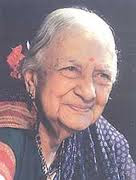 Kamaladevi Chattopadhyay (1903 – 1988) was an Indian social reformer, freedom fighter, and most remembered for her contribution to Indian independence movement, for being the driving force behind the renaissance of Indian handicrafts, handlooms, and theatre in post-Independence India, and for upliftment of the socio-economic standard of Indian women by pioneering the co-operative movement in India. In 1917, when was only fourteen years of age, she was married to Krishna Rao, and within two years she was widowed, while she was still at school. According to orthodox Hindu rules of the times, being a widow she was not allowed to continue her education, yet she defiantly moved to Chennai, and continued her education from St. Mary's School, Chennai and finally completed her high school in 1918.
Kamaladevi Chattopadhyay (1903 – 1988) was an Indian social reformer, freedom fighter, and most remembered for her contribution to Indian independence movement, for being the driving force behind the renaissance of Indian handicrafts, handlooms, and theatre in post-Independence India, and for upliftment of the socio-economic standard of Indian women by pioneering the co-operative movement in India. In 1917, when was only fourteen years of age, she was married to Krishna Rao, and within two years she was widowed, while she was still at school. According to orthodox Hindu rules of the times, being a widow she was not allowed to continue her education, yet she defiantly moved to Chennai, and continued her education from St. Mary's School, Chennai and finally completed her high school in 1918. While still in London, Kamaladevi came to know of Mahatma Gandhi’s Non-Cooperation Movement in 1923, and she promptly returned to India, to join the Seva Dal, a Gandhian organisation set up to promote social upliftment. Soon she was placed in charge of the women's section of the Dal, where she got involved in recruiting, training and organizing girls and women of all ages women across India, to become voluntary workers, 'sevikas'.
In 1926, she met the suffragette Margaret E. Cousins, the founder of All India Women's Conference (AIWC), and was inspired her to run for the Madras Provincial Legislative Assembly. Thus she became the first woman to run for a Legislative seat in India. Though she could campaigned for only a few days, she lost only by 200 votes.
Salt Satyagraha - First Indian woman to be arrested
She was a part of the seven member lead team, announced by Mahatma Gandhi, in the famous Salt Satyagraha (1930), to prepare Salt at the Bombay beachfront, the only other woman volunteer of the team was Avantikabai Gokhale. Later in a startling move, Kamaladevi went up to a nearby High Court, and asked a magistrate present their whether he would interested in buying the 'Freedom Salt' she has just prepared.
On 26 January 1930 she captured the imagination of the entire nation when in a scuffle, she clung to the Indian tricolour to protect it. In the 1930s, she was arrested for entering the Bombay Stock Exchange to sell packets of contraband salt, and spent almost a year in prison. In 1936, she became president of the Congress Socialist Party, working alongside Jayaprakash Narayan, Ram Manohar Lohia and Minoo Masani. When World War II broke out in 1940s Kamaladevi was in England, and she immediately began a world tour to represent India’s situation to other countries and drum up support for Independence after the war.
Post-Independence work
Kamaladevi worked tirelessly helped the refugees to establish new homes, and new professions, for this they were trained in new skills. Thus began the second phase of life's work in rehabilitation of people as well their lost crafts, she is considered single handedly responsible for the great revival of Indian handicrafts and handloom, in the post-independence era, and is considered her greatest legacy to modern India.
Awards and recognition
The Government of India conferred on her the Padma Bhushan (1955) and later the second highest civilian award, the Padma Vibhushan in 1987, which are among the highest civilian awards of the Republic of India. She also received the Ramon Magsaysay Award (1966) for Community Leadership.





0 comments: